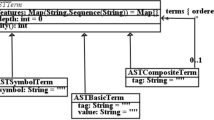The paper presents the final version of the algorithm for translating MSC-2000 documents to event-equivalent Petri nets. The input document may include any elements of the MSC-2000 language, assuming that condition element value is not used and sequential composition of MSC diagrams is regarded as strict. The algorithm is implemented as a full-functional prototype and can be used to verify software systems.
Similar content being viewed by others
References
W. Royce, “Managing the development of large software systems: Concepts and techniques,” in: Proc. IEEE WESCON (1970), pp. 1–9.
CMMI Product Team, CMMI for System Engineering/Software Engineering, Version 1.02, Software Engineering Institute, Carnegie Mellon (2000).
K. Beck, Extreme Programming Explained: Embrace Change, Addison Wesley Longman, Inc. (2000).
A. Cockburn, Agile Software Development, Addison-Wesley, Boston (2001).
S. Kryvyy, L. Matvyeyeva, and M. Lopatina, “Automatic modeling and analysis of msc-specified systems,” Fundamenta Informaticae, 67, No. 1–3, 107–120 (2005).
S. Kryvyy and L. Matvyeyeva, “Algorithm of translation of msc-specified system into Petri net,” Fundamenta Informaticae, 79, No. 3–4, 1–15 (2007).
S. Kryvyi, L. Matvyeyeva, and A. Chugaenko, “Extension of algorithm of translation of msc-specified system into Petri net,” in: Proc. CS\&P’2007 Workshop (2007), 376–387.
S. Kryvyi, L. Matvyeyeva, and A. Chugaenko, “Converting of MSC documents to Petri Nets,” in: Proc. CS\&P’2008 Workshop (2008), pp. 83–93.
ITU-TS Recommendation Z.120: Message Sequence Chart (MSC), Ed. by ITU-TS, ITU-TS, Geneva (2000).
ITU-TS Recommendation Z.120 Annex B: Algebraic Semantics of Message Sequence Charts, Ed. by ITU-TS, ITU-TS, Geneva (1998).
T. Murata, “Petri nets: Properties, analysis and applications,” in: Proc. IEEE, 77, 541–580 (1989).
S. Krivoi, “Criteria of satisfiability for homogeneous systems of linear diophantine constraints,” in: Lecture Notes in Computer Science. Parallel Processing and Applied Mathematics, 2328, 264–271 (2002).
S. L. Kryvyi and A. F. Chugayenko, “Formal methods for analysis of discrete systems using a specification language,” Cybern. Syst. Analysis, 45, No. 4, 528–543 (2009).
Author information
Authors and Affiliations
Corresponding author
Additional information
The study was financed by the Ministry of Education and Science of Ukraine within the framework of the joint Ukrainian-Bulgarian project No. 145/23.02.2009 “Development of distributed virtual laboratories based on advanced access methods for sensory systems design” and by the Bulgarian National Science Fund within the framework of joint Bulgarian-Ukrainian project D002-331/19.12.2008 with the same name.
Translated from Kibernetika i Sistemnyi Analiz, No. 6, pp. 165–171, November–December 2009.
Rights and permissions
About this article
Cite this article
Kryvyi, S.L., Chugayenko, O.V. & Matveeva, L.E. Exploring the properties of MSC documents by translating them into Petri nets. Cybern Syst Anal 45, 997–1003 (2009). https://doi.org/10.1007/s10559-009-9168-3
Received:
Published:
Issue Date:
DOI: https://doi.org/10.1007/s10559-009-9168-3




